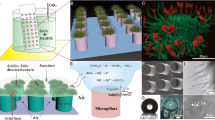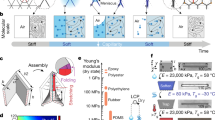Abstract
Soft organic surfaces with more and more complex topologies are required daily to engineer appropriate microstructures for many different applications such as DNA array technology1, biological optics for advanced photonic systems2 and microfluidics3,4. Complementarily to conventional lithographic processes5,6, several pioneering methods have been developed recently, by controlling phase separation of polymer blends7,8, spinodal decomposition of homopolymers9,10 or by using the action of additional external forces driving diverse instabilities11,12. Here we present a method that not only provides original concepts towards the three-dimensional (3D) structuring of liquids, on the basis of the synergistic effects of molecular diffusion and confined nucleation, but also suggests original solutions for the transport, mixing and filtering of small volumes of liquid. Through the intrinsic destabilization of a liquid–liquid bilayer, the 2D pattern of a chemically structured surface with ‘hydrophilic’ and ‘hydrophobic’ domains is transferred to a solid/liquid interface as a 3D topography with either ‘positive’ or ‘negative’ replication. This easy-to-use process has potential applications in various technological realms requiring a specific topography at interfaces such as microfluidics or biosensors.
This is a preview of subscription content, access via your institution
Access options
Subscribe to this journal
Receive 12 print issues and online access
$259.00 per year
only $21.58 per issue
Buy this article
- Purchase on Springer Link
- Instant access to full article PDF
Prices may be subject to local taxes which are calculated during checkout




Similar content being viewed by others
References
Langer, R. & Tirrell, D. A. Designing materials for biology and medicine. Nature 428, 487–492 (2004).
Lee, L. P. & Szema, R. Inspirations from biological, optics for advanced photonic systems. Science 310, 1148–1150 (2005).
Delamarche, E., Juncker, D. & Schmid, H. Microfluidics for processing surfaces and miniaturizing biological assays. Adv. Mater. 17, 2911–2933 (2005).
Squires, T. M. & Quake, S. R. Microfluidics: Fluid physics at the nanoliter scale. Rev. Mod. Phys. 77, 977–1026 (2005).
Xia, Y., Rogers, J. A., Paul, K. E. & Whitesides, G. M. Unconventional methods for fabricating and patterning nanostructures. Chem. Rev. 99, 1823–1848 (1999).
Xia, Y. et al. Complex optical surfaces formed by replica molding against elastomeric masters. Science 273, 347–349 (1996).
Boltau, M., Walheim, S., Mlynek, J., Krausch, G. & Steiner, U. Surface-induced structure formation of polymer blends on patterned substrates. Nature 391, 877–879 (1998).
Heriot, S. Y. & Jones, R. A. L. An interfacial instability in a transient wetting layer leads to lateral phase separation in thin spin-cast polymer-blend films. Nature Mater. 4, 782–786 (2005).
Herminghaus, S. et al. Spinodal dewetting in liquid crystal and liquid metal films. Science 282, 916–919 (1998).
Higgins, A. M. & Jones, R. A. L. Anisotropic spinodal dewetting as a route to self-assembly of patterned surfaces. Nature 404, 476–478 (2000).
Schäffer, E., Thurn-Albrecht, T., Russell, T. P. & Steiner, U. Electrically induced structure formation and pattern transfer. Nature 403, 874–877 (2000).
Schäffer, E., Harkema, S., Roerdink, M., Blossey, R. & Steiner, U. Morphological instability of a confined polymer film in a thermal gradient. Macromolecules 36, 1645–1655 (2003).
Seemann, R., Herminghaus, S. & Jacobs, K. Dewetting patterns and molecular forces: A reconciliation. Phys. Rev. Lett. 86, 5534–5537 (2001).
Kargupta, K. & Sharma, A. Templating of thin films induced by dewetting on patterned surfaces. Phys. Rev. Lett. 86, 4536–4539 (2001).
Love, J. C., Estroff, L. A., Kriebel, J. K., Nuzzo, R. G. & Whitesides, G. M. Self-assembled monolayers of thiolates on metals as a form of nanotechnology. Chem. Rev. 105, 1103–1169 (2005).
Bico, J. & Quéré, D. Self-propelling slugs. J. Fluid Mech. 467, 101–127 (2002).
de Gennes, P.-G., Brochard-Wyart, F. & Quéré, D. Capillarity and Wetting Phenomena: Drops, Bubbles, Pearls, Waves (Springer, New-York, 2004).
Reiter, G. et al. Thin film instability induced by long-range forces. Langmuir 15, 2551–2558 (1999).
Schäffle, C., Leiderer, P. & Bechinger, C. Subpattern formation during condensation processes on structured substrates. Europhys. Lett. 63, 394–400 (2003).
Lopez, G. P., Biebuyck, H. A., Frisbie, C. D. & Whitesides, G. M. Imaging of features on surfaces by condensation figures. Science 260, 647–649 (1993).
Kumar, A. & Whitesides, G. M. Pattern condensation figures as optical diffraction gratings. Science 263, 60–62 (1994).
Steyer, A., Guenoun, P. & Beysens, D. Growth of droplets on a substrate by diffusion and coalescence. Phys. Rev. A 44, 8271–8277 (1991).
Viovy, J. L., Beysens, D. & Knobler, C. M. Scaling description for the growth of condensation patterns on surfaces. Phys. Rev. A 37, 4965–4970 (1988).
Narhe, R. D. & Beysens, D. A. Nucleation and growth on a superhydrophobic grooved surface. Phys. Rev. Lett. 93, 076103 (2004).
Lenz, P. & Lipowsky, R. Morphological transitions of wetting layers on structured surfaces. Phys. Rev. Lett. 80, 1920–1923 (1998).
Gau, H., Herminghaus, S., Lenz, P. & Lipowsky, R. Liquid morphologies on structured surfaces: From microchannels to microchips. Science 283, 46–49 (1999).
Debregeas, G., de Gennes, P.-G. & Brochard-Wyart, F. The life and death of “bare” viscous bubbles. Science 279, 1704–1707 (1998).
Acknowledgements
We wish to thank D. Beysens, S. Dietrich, A. Jonas and G. Reiter for fruitful discussions. This work was supported by the Belgian National Funds for Scientific Research (FNRS), the Government of the Region of Wallonia (CORRONET Research Programme) and the European Commission (Phasing out, MateriaNova). P.D. is a research Associate of the FNRS.
Author information
Authors and Affiliations
Corresponding authors
Ethics declarations
Competing interests
The authors declare no competing financial interests.
Rights and permissions
About this article
Cite this article
Léopoldès, J., Damman, P. From a two-dimensional chemical pattern to a three-dimensional topology through selective inversion of a liquid–liquid bilayer. Nature Mater 5, 957–961 (2006). https://doi.org/10.1038/nmat1787
Received:
Accepted:
Published:
Issue Date:
DOI: https://doi.org/10.1038/nmat1787
This article is cited by
-
Giant Slip Induced Anomalous Dewetting of an Ultrathin Film on a Viscous Sublayer
Scientific Reports (2017)
-
Mechanically Modulated Dewetting by Atomic Force Microscope for Micro- and Nano- Droplet Array Fabrication
Scientific Reports (2014)
-
Self-Organized Micropatterning of Thin Viscous Bilayers Under Microgravity
Microgravity Science and Technology (2010)
-
Wafer-scale controlled Au/Pt bimetallic flowerlike structure array
Gold Bulletin (2008)



